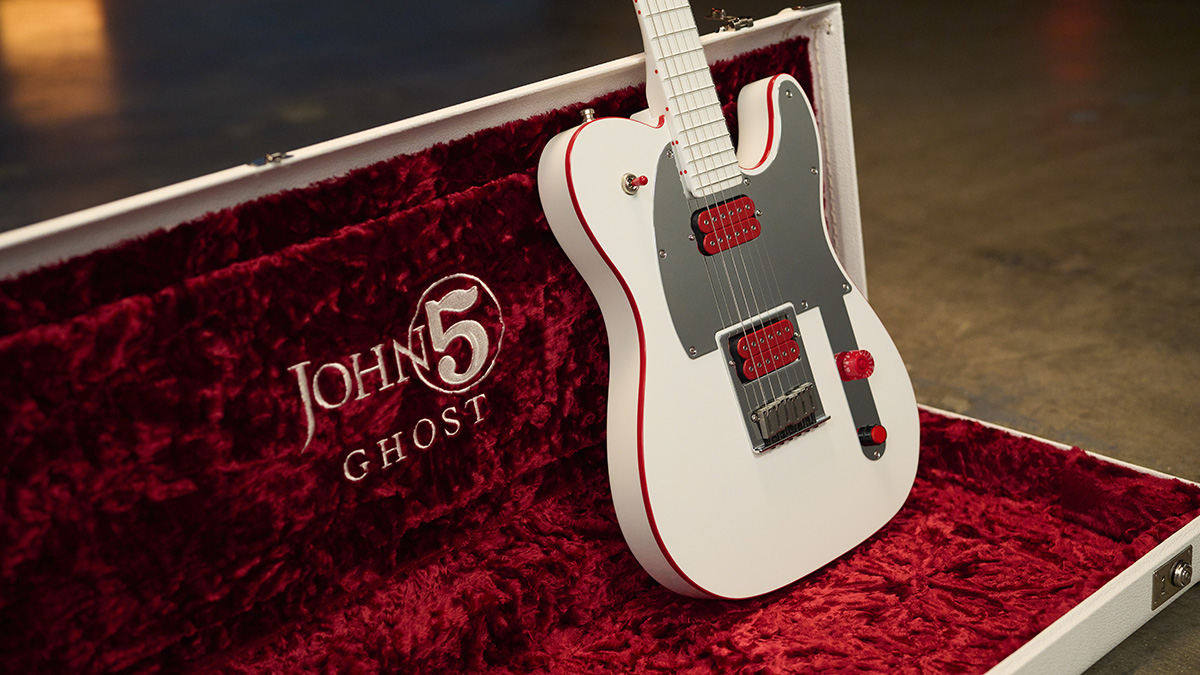“Buckethead made me want to explore the idea of using a kill switch. I love how creative you can get”: How John 5 revolutionized one of Fender’s oldest guitar designs with the Ghost Telecaster
The Mötley Crüe gunslinger explains how fashion brand Supreme inspired his latest signature guitar, what makes his favorite pickups ideal for everything from country to metal – and why no-one is a bigger Buckethead fan than he is

Though there have been a few signature guitars in the past – the first being the Squier J5 Telecaster launched in 2009 and the two Custom Shop instruments that came after – this year marks the first John 5 model to be produced in the “regular” Fender factory.
The heavily customized Ghost Telecaster features a one-piece maple neck and alder body, as well as a pair of ceramic magnet DiMarzio D Activator humbuckers, a three-way toggle mounted to its upper bout and an Arcade-style kill switch.
It’s been a few years in the making – but only because the guitarist wanted to road test the instrument before committing to its final specs. Given that it’s his name appearing on the neck plate found on the rear, you can’t really blame him.
“I’m very proud of this guitar,” John 5 tells GW. “I insisted on putting it through the wringer first and taking it on tour before the final release. I didn’t want anything to go wrong, so I was trying to see if the white paint would wear off or if the toggle might break.
“The only way to make sure of the quality was to take it out for a few years. I was constantly using it and sweating all over it… nothing happened. This stuff won’t break or wear away. It looks and sounds unbelievable and is 100 percent tough. Basically, it’s a road guitar.”

Unlike the Ghost model seen in his hands on Mötley Crüe’s current tour, the all-new production model comes with a vintage-style six-saddle bridge instead of a Floyd Rose, though he teases that “a double-locking tremolo system could be a good idea for the next run.”
What might surprise some readers is that the concept of an Arctic White finish with striking red appointments was partly inspired by another Fender instrument in the guitarist’s possession – a limited-edition model designed in collaboration with, believe it or not, New York fashion brand Supreme.
Get The Pick Newsletter
All the latest guitar news, interviews, lessons, reviews, deals and more, direct to your inbox!
“I have to give credit where it’s due,” he says. “I once saw and ended up buying a guitar Fender put out with Supreme. I still own it and I think it looks insane. When we were starting to work on the Ghost, I said, ‘Hey, can we do something like this where the neck and fretboard come completely white?’ This is what we ended up with.”

As the guitarist goes on to explain, every aspect of the new signature was carefully thought out. For example, the toggle switch is on the upper bout like the Telecaster Custom models of the ’70s, so it doesn’t get in the way of his picking hand (“It’s easier to have it higher up and out of the way,” he says).
As well as protecting the ash body, the chrome pickguard doubles up as a mirror for reflecting spotlights and final checks before hitting the stage.
“This pickguard was designed a little bit differently,” John 5 says. “They’re usually made out of two pieces, but I pleaded and pleaded with Fender to make it just one. So it’s the same bit that goes into the volume, tone and kill switch controls. When I’m picking frantically, I don’t want to feel that connection where they meet. It triggers my brain and could make me lose concentration.
“Another bonus is when the spotlight hits you on stage, you can reflect it back into the crowd. It’s like having a light beaming out of my guitar, which looks so cool. And I know this sounds silly – but it’s very true – if you play this guitar live, you can use it as a mirror. It’s a pretty handy feature! The other guys and gals in the band will love you for it.” [Laughs]
While they are medium to high in output, the two passive DiMarzio D Activator humbuckers are deceptively versatile and perfectly balanced to cover everything from country twang to heavy metal thunder. Genre-crossing guitar players like him, he notes, require well-rounded pickups that pack enough punch where needed.
“Even when I’m playing regular country music, I always want a little grit. I’ve been around a lot of those country pickers and they tend to be quite loud, which is exactly how those D Activators sound. They work perfectly for country, Crüe and my solo music. I’ve tried many pickups, but the ones that work best for me are undoubtedly the D Activators.”

If a vintage-style guitar finished in a very modern white with red features, ceramic magnet pickups and a kill switch sounds a bit familiar, it might very well be down to John 5 counting himself as one of Buckethead’s biggest fans. Listen to the instrumental solo works of either guitarist and you’ll easily be able to detect heavy doses of freakish inventiveness and chicken picking in their compositions and approaches.
“No-one is a bigger Buckethead fan than me!” John 5 says. “I love to go to his shows and get inspired. That’s one of the most important things about being creative. When you find the person or thing that really inspires you, it’s always best to roll with it. What Bucket’s done with instrumental music has inspired me greatly. I actually think he’s the reason I ended up doing my own instrumental stuff.
“You see him live and it might just be him on stage with a backing track. I thought it was absolutely unbelievable when I first saw that. People like him made me want to explore the idea of using a kill switch. I love how creative you can get and use mine all the time, so why not add it as an extra feature?”
- For more information on the John 5 Ghost Telecaster, head to Fender.com.
Amit has been writing for titles like Total Guitar, MusicRadar and Guitar World for over a decade and counts Richie Kotzen, Guthrie Govan and Jeff Beck among his primary influences as a guitar player. He's worked for magazines like Kerrang!, Metal Hammer, Classic Rock, Prog, Record Collector, Planet Rock, Rhythm and Bass Player, as well as newspapers like Metro and The Independent, interviewing everyone from Ozzy Osbourne and Lemmy to Slash and Jimmy Page, and once even traded solos with a member of Slayer on a track released internationally. As a session guitarist, he's played alongside members of Judas Priest and Uriah Heep in London ensemble Metalworks, as well as handled lead guitars for legends like Glen Matlock (Sex Pistols, The Faces) and Stu Hamm (Steve Vai, Joe Satriani, G3).
“It holds its own purely as a playable guitar. It’s really cool for the traveling musician – you can bring it on a flight and it fits beneath the seat”: Why Steve Stevens put his name to a foldable guitar
“Finely tuned instruments with effortless playability and one of the best vibratos there is”: PRS Standard 24 Satin and S2 Standard 24 Satin review



![A black-and-white action shot of Sergeant Thunderhoof perform live: [from left] Mark Sayer, Dan Flitcroft, Jim Camp and Josh Gallop](https://cdn.mos.cms.futurecdn.net/am3UhJbsxAE239XRRZ8zC8.jpg)







